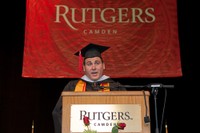
Four years after the Community Park opened, the Rutgers–Camden softball team won the NCAA Division III National Championship Title and became the first Rutgers team to win an NCAA title in more than 60 years. More athletic advances include the acquisition of a driving range at Cooper River Park in 2008, the start of a women’s lacrosse program in 2010, and the opening of the Rutgers-Camden Athletic and Fitness Center in 2009. The renovated 75,000 square-foot facility now offers top-of-the line cardio and strength-training equipment, a resistance pool, team locker rooms, and a recreation program space for yoga, spinning, and Pilates.
In 2005, Dr. Milton Leontiades retired as dean of the Rutgers School of Business–Camden with Dr. Mitchell Koza, an international management scholar, taking on this leadership role the year following. Dr. Koza returned to his research and teaching passions in 2009.
The 21st century continued to bring positive change to the Campus with the dedication of a major new facility, the launch of new academic programs, and the appointment of a new chancellor after a national search.
On April 3, 2009 a dedication ceremony of the new 53,000 square-foot law school facility drew hundreds of supporters from across the state. Dubbed “Law School East,” the four-story facility at Fifth and Penn Streets allows Rutgers’ legal clinics to better deliver more than 30,000 hours of free legal service annually.
More academic offerings launched, including the nation’s first doctoral degree in childhood studies, additional doctoral degrees in computational biology and public policy, a comprehensive four-year undergraduate program in business, and an MFA program in creative writing, which now oversees the reputable literary journal Story Quarterly.
In 2008-09, Rutgers selected a new chancellor for the Camden Campus. Dr. Wendell E. Pritchett, a former professor at the University of Pennsylvania Law School, started his new position on June 30, 2009. The author of two books and numerous articles on topics relating to urban history and policy, Dr. Pritchett served as deputy chief of staff and director of policy for Philadelphia Mayor Michael Nutter and chaired the Urban Policy Task Force for U.S. Senator Barack Obama’s presidential campaign. Dr. Margaret Marsh, dean of the Rutgers–Camden Faculty of Arts and Sciences, served as interim chancellor since the retirement of Provost Roger Dennis in 2007. Dr. Marsh worked to improve Campus enrollment and retention efforts and established two new public works of art on campus: “Walt Whitman with Butterfly” and the Gateway, which is reflective of many of the Campus’ capital improvements.

The Camden Campus continues to make great strides in its missions to teach, research, and serve the larger community. Thanks to funding from the Annie Casey Foundation the establishment of an Office of Civic Engagement, an initiative set forth by Chancellor Pritchett, Rutgers–Camden aims to better develop its relationship with its urban neighbors in need. As the campus reached its highest enrollment ever at 6,100 students, a goal to grow the student body to 7,500 within five years has been announced.
A desire to expand on-campus housing has also been expressed by Rutgers–Camden administration. Plans are also in the works to secure additional space for parking and for playing fields for lacrosse and track teams.
According to Chancellor Pritchett, “our 60th anniversary is an opportunity to remind the world about the critical role of Rutgers–Camden in transforming lives and building optimism for the future.”
Media Contact: Cathy K. Donovan
(856) 225-6627
E-mail: catkarm@camden.rutgers.edu